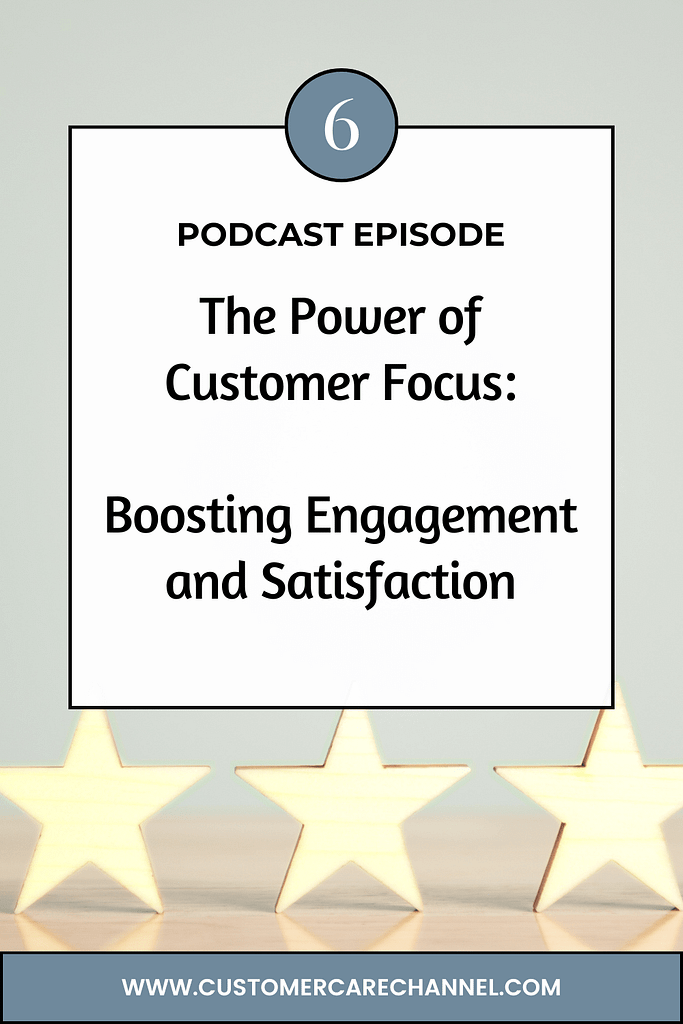This site contains affiliate links, view the disclosure for more information.
LISTEN OR SUBSCRIBE FOR FREE IN YOUR FAVOURITE PODCAST APP: Apple Podcasts – Spotify – RSS
This podcast episode is all about the Power of Customer Focus: Boosting Engagement and Satisfaction.

Become Customer Focus
If you are looking to become a customer focused business, this is the episode I recommend. This episode gives a customer focus definition and provides tips and tricks for boosting customer satisfaction.
Resources Mentioned
Making Changes to Your Business: A Step-by-Step Guide
Welcome back to the Customer Care Channel. Today, we’re diving into the topic of making changes within your business. At first glance, this might seem straightforward—decide to change, and it’s done. But is it that simple? Not quite. Let’s explore how to make meaningful changes effectively.
Why Change Is Essential for Business Growth
Have you considered the potential impact of unplanned changes on your business? Change isn’t just about fixing what’s broken; it’s about continuous improvement. By addressing issues proactively, you can enhance customer satisfaction, streamline processes, and reduce inefficiencies.
Benefits of Making Strategic Changes
Implementing well-thought-out changes in your business offers several benefits:
- Improved efficiency: Reducing time spent on repetitive tasks and fixes.
- Enhanced customer experience: Avoiding frequent issues that frustrate customers.
- Better team dynamics: Encouraging a culture of innovation and initiative among your staff.
Creating a Culture of Continuous Improvement
To succeed, businesses must foster a culture where continuous improvement is the norm. Here’s how:
- Hire the right people: Look for team members passionate about innovation and problem-solving.
- Encourage proactive solutions: Create an environment where employees feel comfortable suggesting changes.
Planning for Change: What You Need to Know
Before diving into a change, it’s essential to plan. Use a structured approach to document and manage the process.
The Importance of a Change Management Template
A change management template ensures consistency and clarity. Here’s what it should include:
- Change number: Assign a unique identifier for tracking.
- Title: Provide a concise description of the change.
- Status: Track progress as “draft,” “in progress,” or “complete.”
- Priority level: Categorize changes as minor, medium, urgent, or emergency.
- Detailed steps: Document the exact steps to implement the change.
How to Implement Major Changes Effectively
- Define the problem: Provide a summary and detailed description of what needs to change.
- Step-by-step plan: List actionable steps so anyone can implement the change in your absence.
- Backup your data: Mitigate risks by securing a backup before proceeding.
- Test the process: Validate each step in a test environment to ensure success.
- Schedule wisely: Use analytics to choose the least disruptive time for implementation.
Communicating Changes to Your Audience
Keep your customers and team informed about upcoming changes:
- Use banners or pop-ups on your website to announce maintenance or updates.
- Consider emailing customers to highlight improvements, encouraging them to explore new features.
The Importance of Team Involvement in Change Management
Present proposed changes to your team before implementation. This allows for feedback, cross-department collaboration, and ensures everyone is aligned.
What to Do After the Change: Lessons Learned
After implementing a change, conduct a “lessons learned” review:
- What worked well? Highlight successes.
- What didn’t work? Identify areas for improvement.
- Customer feedback: Assess the impact on customer satisfaction.
Tracking Changes for Future Reference
Maintain a spreadsheet to track all changes, including:
- Change numbers
- Titles
- Dates of implementation
This log will help you review past actions and avoid redundancy in future updates.
Final Thoughts on Business Change Management
Change is inevitable, but managing it effectively is key to minimizing disruptions and maximizing benefits. Use the tips and templates shared in this blog to streamline your approach.
If you have any questions or need additional support, feel free to reach out via email. I’ll include my contact information in the show notes below. Until next time, happy improving!
Thank You for Listening!
To start managing your customer experience, the first step is to understand your customers. Who are they? What do they want? This is where creating a *customer avatar* can be incredibly useful. A customer avatar helps you picture your ideal customer, so you can make decisions that suit their needs and preferences. To help you get started, I’ve put together a free customer avatar template. Just subscribe to my email list, and you’ll get access to it straight away from your inbox.
More Tips for Learning About Customer Experiences
- 3 Reasons Why Customer Experience is So Important
- Why Good Customer Service Makes You Stand Out
- 5 Mistakes You Make With Frustrated Customers!

